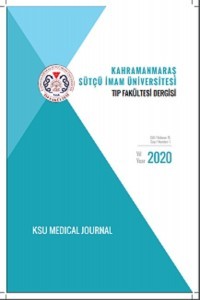Cerrahi Alan Enfeksiyonlarının Değerlendirilmesi
Cerrahi Alan enfeksiyonu, Konak faktörleri, Preoperatif dönem
Evaluation of Surgical Site Infections
Surgical site infection, host factors, preoperative period,
___
- Referans1. Tanner J, Padley W, Assadian O, Leaper D, Kiernan M, Edmiston C. Do surgical care bundles reduce the risk of surgical site infections in patients undergoing colorectal surgery? Asystematic review and cohort meta-analysis of 8,515 patients. Surgery, 2015;158(1):66-77.
- Referans2. Ulu AC. Cerrahi Alan Enfeksiyonları Turkiye Klinikleri J Inf Dis-Special Topics 2016;9(3):22-9.
- Referans3. Mangram AJ, Horan TC, Pearson ML, Silver LJ, Jarvis WR Guideline for prevention of surgical site infection,1999. AJIC 1999;27:97-134.
- Referans4. Moro ML, Toni A, Stolfi I, Carrieri MP, Braga M, Zunin C. Risk factors for nosocomial sepsis in newborn intensive and intermediate care units. Eur J Pediatr 1996;155:315-22.
- Referans5. Yalçın AN. Nozokomiyal Sepsis: Risk Faktörleri, Hastanede Yatış Süresi, Ek Maliyet, Prognozu Etkileyen Faktörler ve Mortalite. Hastane İnfeksiyonları Dergisi 1998;2:230236.
- Referans6. Bozfakioğlu Y. Cerrahi alan infeksiyonlarında patogenez ve sınıflama. Hastane İnfeksiyonları Dergisi 2001;5:91-94.
- Referans7. Kao LS, Meeks D, Moyer VA, Lally KP. Peri-operative glycaemic control regimens for preventing surgical site infections in adults. Cochrane Database Syst Rev. 2009;8;(3):CD006806.
- Referans8. Taş S, Dönmez AA, Tunçer EY, Adademir T, Yanartaş M, Sunar H. Açık Kalp Cerrahisi Hastalarında Diyabet ve Kan Glukozu Kontrolünün Cerrahi Alan Enfeksiyonları Üzerine Etkisi. Koşuyolu Kalp Dergisi 2013;16(3):199-204.
- Referans9. Fukuda Y, Yamamato K, Hiroa M, Nishikawa K, Maeda S, Haraquchi N, et al. Prevalance of malnutrition among gastric cancer patients undergoing gastrectomy and optimal preoperative nutritional support for preventing surgical site ınfections. Annals of Surgical Oncology 2015;22(3):778-85.
- Referans10. Klein JD, Hey LA, Yu CS, Klein BB, Coufal FJ, Young EP, et al. Perioperative nutrition and postoperative complications in patients undergoing spinal surgery. Spine 1996; 21(22):2676-82.
- Referans11. Malone DL, Genuit T, Tracy JK, Gannon C, Napolitano LM. Surgical site infections: reanalysis of risk factors. J Surg Res 2002;103(1):89-95.
- Referans12. Meng F, Cao J, Meng X. Risk factors for surgical site infection following spinal surgery. Journal of Clinical Neuroscience 2015;22(12):1862-6.
- Referans13. Mangram, AJ, Horan TC, Pearson ML, Silver LC, Jarvis WR. CDC Guideline for prevention of surgical site infection, 1999. Infection Control and Hospital Epidemiology 1999;20(4):247-278.
- Referans14. Nathens AB, Dellinger EP. Surgical site infections. Current Treatment Options in Infectious Diseases 2000;2:347-358.
- Referans15. Yavuz SŞ, Tarçın O, Ada S, Dinçer F, Toraman S, Birbudak S, et al. Incidence, aetiology, and control of sternal surgical site infections. J Hosp Infect. 2013;85(3):206-12.
- Referans16. Heys SD, Walker LG, Smith I, Eremin O. Enteral nutritional supplementation with key nutrients in patients with critical illness and cancer: A metaanalysis of randomized controlled clinical trials. Ann Surg 1999;229:467–77.
- Referans17. Garibaldi RA, Skolnick D, Lerer T, Poirot A, Graham J, Krisuinas E, et al. The impact of preoperative skin disinfection on preventing intraoperative wound contamination. Infect Control Hosp Epidemiol 1988;9:109-113.
- Referans18. Earnshaw JJ, Berridge DC, Slack RC, Makin GS, Hopkinson BR. Do preoperative chlorhexidine baths reduce the risk of infection after vascular reconstruction. Eur J Vasc Surg 1989;3:323-326.
- Referans19. Chosky SA, Modha D, Taylor GJ. Optimisation of ultraclean air. The role of instrument preparation. J Bone Joint Surg Br 1996;78:835-7.
- Referans20. Seropian R, Reynolds BM. Wound infections after preoperative depilatory versus razor preparation. Am J Surg. 1971;121(3):251-4.
- Referans21. Culver DH, Horan TC, Gaynes RP, Martoni WJ, Jarvis WR, Emori TG, et al. Surgical wound infection rates by wound class, operative procedure, and patient risk index. Am J Med 1991;91:152-7.
- ISSN: 1303-6610
- Yayın Aralığı: Yılda 3 Sayı
- Başlangıç: 2004
- Yayıncı: Kahramanmaraş Sütçü İmam Üniversitesi
Olgularla Hematolojik ve Onkolojik Aciller
Can ACIPAYAM, Tuğba KANDEMİR GÜLMEZ, Muhammed PARLAR, Osman Nuri ÖZEN, Salim EKİCİ, Mehmet ÖRENLER
Kadın Doğum ve Çocuk Hastanesinde Doğum Yapan Kadınların Doğum Öncesi Bakım Alma Durumları
Filiz TAŞ, Merve GÜLPAK, Ayşe Aslı OKTAY, Nevres DEMİR
Kliniğimizde Tedavi Gören Suriyeli Hastaların Değerlendirilmesi
Fatma BİLGEN, Alper URAL, Mehmet BEKERECİOĞLU
Astım ve KOAH Hastalarının Fiziksel Aktivite Düzeylerinin Değerlendirilmesi
Filiz ÖZDEMİR, Tuba KOCA, Nurcan BERBER, Şelale ŞAHİN
İnme Hastalarında Tam Kan Sayımı Parametreleri Fonksiyonel Seviyeyi Gösterir mi?
Cerrahi Alan Enfeksiyonlarının Değerlendirilmesi
Selma ATEŞ, Selçuk NAZİK, Ahmet Rıza ŞAHİN, Fadime KARDAŞ, Ayşegül ERDOĞAN
Tirofiban'a Bağlı Diffüz Alveolar Hemoraji ECMO ile Tedavi Edilebilir mi?
Murat KERKÜTLÜOĞLU, Hakan GÜNEŞ, Erdinç EROĞLU
Gizli Tehdit: Et Yiyen Zoonoz Bakteriler
Aliye SAĞKAN ÖZTÜRK, Serkan İrfan KÖSE
